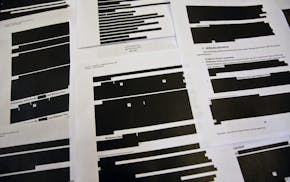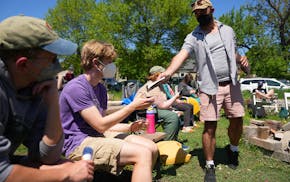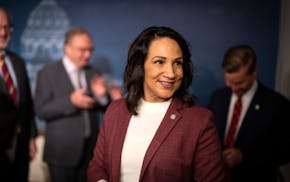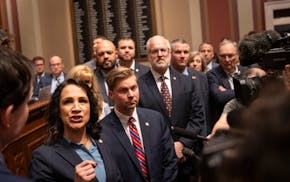St. Paul Fire Chief Butch Inks grew up near Rice Street and went to Como Park High School, where he played football, hockey and baseball. His first city job was as a teenage recreation worker. After high school, Inks joined the military and became a St. Paul firefighter, rising to assistant chief.
So, when Mayor Melvin Carter named Inks chief on Nov. 1, 2019, it seemed it was Inks' destiny. Thing is, he said he didn't want the job. His two years as assistant chief were miserable, he said, and the relationship between former Chief Tim Butler and the firefighters' union had been toxic.
"There was just a lot of conflict. A lot of lack of progress being made," Inks said. "And that's not who I am."
Inks changed his mind after realizing he could change the narrative.
In August 2020 — when the COVID-19 pandemic was in full swing and shortly after the unrest that followed George Floyd's murder in Minneapolis — Inks and an assistant chief were sued in federal court for allegedly retaliating against a whistleblower regarding training practices. In September 2022, a judge dismissed the suit with prejudice. In the past year, the department has added 65 firefighters, bringing it back to pre-pandemic strength.
Eye On St. Paul sat down with the 53-year-old chief last week. This interview was edited for length.
Q: Tell me a little about your background.
A: I grew up at 486 Stinson St., which is in the Rice Street area of St. Paul. I currently live in Roseville, less than two miles from where I grew up, a block out of the city.
Q: When did you graduate from Como?
A: 1987. I played football, hockey and baseball in high school. Still skate to this day — actually playing tonight.
Q: Where do you play?
A: So, the Wild are having Firefighter Appreciation Night. After the Wild game, Minneapolis Fire is playing against us, St. Paul Fire. I wasn't going to play because it's so late for me [laughs]. But my son works for Minneapolis Fire. And he plays hockey.
Q: What did you do after Como?
A: I went in the military. Air Force Reserves.
Q: Have you always wanted to be a firefighter?
A: I always wanted to be of service. I started with the city when I was 15 years old. I grew up across the street from Front Playground. I'd put my skates on at home and I'd walk across the street to play hockey. One day, I was shooting baskets, and the director at the time came over and asked if I wanted a job. And I said, "Sure, what do I do?" And he said, "Exactly what you're doing."
Q: How long did you do that?
A: I did it until I got hired in the fire department. I staffed the rec center until I went into the military. When I came back from basic [training], I got reassigned to a different rec center. From there, I took the fire test.
Q: How did you become chief?
A: I remember going through the process, doing my interview with the mayor. I was the interim chief first. Actually, nobody wanted to do it. [laughs] I said, "I'll do it [interim], but not doing it [permanently]."
Q: Why not?
A: I'd been the assistant chief for a while, and it was a horrible experience, a horrible time in the department.
Q: What was the cause?
A: The union at the time and the chief at the time didn't get along.
Q: What changed?
A: I went back to [being] deputy [chief at a station]. I enrolled in school [University of Northwestern in St. Paul]. None of my siblings or mom or dad have their college degree. My wife has hers. And so, life is good. I'm a deputy. I'm running a shift.
And our chief [Butler] literally left one day. Like, left.
A couple of the assistant chiefs here asked if I would step in. I ran it by my wife and before I could get it out of my mouth, she's like "No." But I said, "I can be home every night, it's not permanent. Let's just step in for a while. I can always go back." So, I step in and quickly realize, you can change this place.
Q: What was the first step?
A: I called a meeting. We had unions in there. We had chiefs in there. And I went, "Listen, everyone we've blamed in the past no longer works here. It's just us. So, if we want to make progress, we have to stop doing this."
Q: You offered a clean slate?
A: I was the chiefs' union president for a while. I understand their role and their process, and it's important. I respect that. And I respect that they offer a lot of value for our fire department.
Q: What did you do to get them to believe you?
A: I don't say anything that's not true. If I'm going to do something or we're going to have to change something, then I'm going to tell you that.
Q: How many firefighters do you have?
A: We have 434 sworn positions. And we have our new division, which we created in 2019, our Basic Life Support division. Again, I could see that what we were doing wasn't working as efficiently as it should be. And it also creates opportunities for kids who want to be firefighters. We started the division with 12, we're getting 6 more in 2023. And when we start 2023, we'll have 30 positions.
Q: What makes the St. Paul Fire Department unique?
A: The opportunities. Not only do we go to fires, but we're also water rescue. We have Hazmat. We are the only helicopter rescue team in the state of Minnesota — we partner with the State Patrol. But we're also out in the schools. Reading to kids. We're bigger than just going to a fire.
I would like to take credit, but I can't. It's the men and women of this department who are always ready to step up to the challenge.

Want to share info with the Star Tribune? How to do it securely

'Safe recovery sites' would offer syringes, naloxone and more to people using drugs. The plan could be in peril.
New Minnesota GOP leaders seek peace with party's anti-establishment wing

Who is Republican Lisa Demuth, Minnesota's first House speaker of color?
